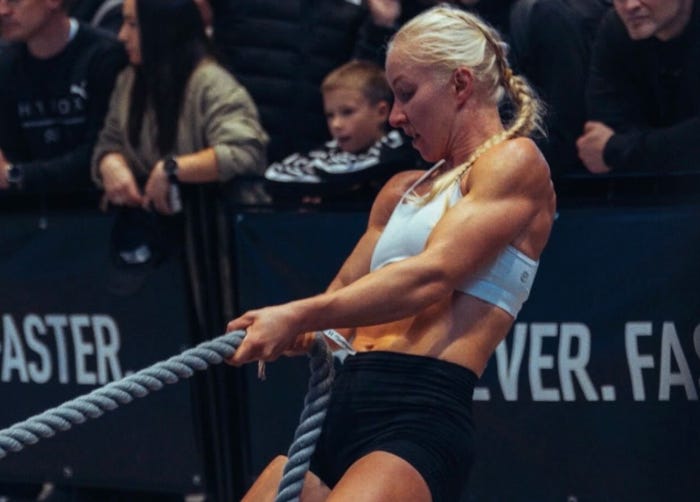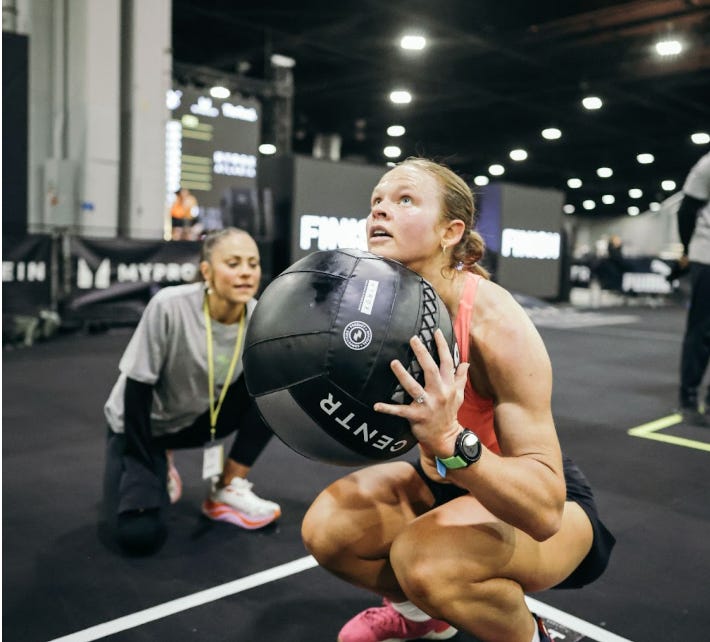How Elli Stenfors learned to love to suffer
Elli Stenfors is a physiotherapist, coach, and athlete who has been carving out space at the front of the women’s field with steady, understated determination. Her 1:01:05 in Stuttgart has made her the newest member of the Hyrox Elite 15. With roots in CrossFit and a training philosophy built around focused, uncomplicated work, Elli has developed a style defined by resilience, intuition, and a willingness to lean into the hard moments.
The Hybrid Letter spoke with her about the mindset that drives her training, how she handles race-day nerves, and what helps her perform at her best.
This interview has been edited for length and clarity.
The Hybrid Letter: You’re a physio as well as a coach and athlete. What first drew you toward physiotherapy and helping people in this way?
Elli Stenfors: I came from a swimming background when I was younger, and eventually I just got bored doing only that. My swimming coach suggested I try CrossFit, and I fell in love with it right away. It was fun, I was good at it, and I liked the variety. But along the way I had a few minor injuries, and I didn’t feel like I really had support around how to handle them. I never skipped training—I always found a way to work around whatever was hurting—which forced me to learn how to train safely on my own. That’s how I learned to listen to my body and understand what actually worked for me.
That experience made me want to become the person I didn’t have at the time. I wanted to be someone who could help others stay healthy, recover well, and perform better. Studying physiotherapy gave me the deeper understanding of the body that I wanted, and combining that knowledge with coaching felt natural. I didn’t want to help people only after they got hurt—I wanted to help them perform at their best before they reached that point.
THL: When did Hyrox enter the picture for you?
ES: At first it was very casual. I was training at a tiny private gym with a small group, and someone said, “Hey, have you heard about this hybrid thing?” This was in 2022. None of us really knew what it was, but we decided to try it. So eight of us went. We all suffered, had fun, and then honestly kind of forgot about it afterward. It felt like a one-time experiment.
Back then I was still competing in CrossFit at an international level, so that was where my focus was. But over time I started drifting more toward hybrid events. I did one Hyrox race in 2022, and then this year it came back to Switzerland, where I live. I’m not even sure what reminded me—maybe because I coach Hyrox athletes and everyone around me was signing up—but I decided to compete myself.
I improved my time a lot, realized I had real potential, and since I won that race, I qualified immediately for the World Championships. That was the moment everything shifted. I trained more specifically for Worlds in June, raced even better, and that’s when I knew I wanted to try to reach the elite level. It suddenly felt possible.
THL: A lot of athletes talk about their first Hyrox as a shock to the system. Was there anything that genuinely surprised you?
ES: Not really. It was the right amount of pain, and I loved it from the first moment. I’ve always gravitated more toward endurance than pure strength, and I enjoy pushing myself, getting out of breath, suffering a little. Hyrox clicked immediately for me. And because of my CrossFit background, the combination of movements didn’t feel foreign at all. It made sense to my body.
THL: What shifted in your training once you moved from CrossFit toward Hyrox? What did you have to change?
ES: The biggest change was adding a lot more running. After I finished CrossFit competition, I trained for an Ironman because it was a bucket-list goal. I spent a few months mostly on the bike and running, and once I did the race, I realized I genuinely enjoyed running. That made Hyrox a natural fit because of how much running is involved.
My Hyrox training looks very different from what most people do. A lot of athletes do mixed pieces—running plus several movements in a row, or big circuits with many stations. I prefer keeping things simple. I’ll focus on one or two movements at a time, target specific energy systems, and push myself in a very controlled way. I don’t do large circuits with every Hyrox movement in a single workout. That doesn’t give me the stimulus I’m looking for.
I coach people as well, and many enjoy following my plans because the approach is different. I run a lot, but mostly easy runs. I don’t really do intervals like most people. If I want something hard, I usually choose the machines in the gym. I still push myself, but not in that classic interval-running structure.
THL: In a race, where do you feel your strengths show up the most?
ES: Definitely toward the end of the race—sandbag lunges and wall balls. It’s funny because I hate wall balls. In training, they’re one of my least favorite movements. But in a race something shifts. The lunges are strong for me, and mentally by that point I’m really locked in, so I can push through.
In my last three races I’ve done the wall balls unbroken, which I’ve never done in training. That really shows how strong the mental side is for me on race day. When I train, I just train—I don’t try to simulate race conditions. I have hard sessions, but I don’t dig as deep as I do in a race. I like saving that final mental gear for when it actually matters.
I also like not racing too frequently. It gives me time to mentally reset. When I had two races within three weeks this season, it was intense for me.
THL: What’s going through your mind when it starts to hurt? Do you use any mental cues or specific self-talk?
ES: I don’t have a single mantra, but the thought I repeat is that I love the pain. I give myself a few easier days before a race so I feel prepared, and then when the race starts, I tell myself, “Now it’s time to suffer.” If I want to reach the goals I have, I need to go through that discomfort. During the race I remind myself how much I want it and how deep I’m willing to push. That feeling is something I genuinely enjoy.
THL: You talk a lot about fueling, both for yourself and in your coaching. How central is nutrition to your performance?
ES: It’s huge. I think it’s probably one of the strongest parts of my performance. I train a lot, so I need to eat well and feel good, and that’s something I pay close attention to with my clients. The most important thing is simply eating enough. Everyone has to figure out how many meals work for them and what timing they prefer, but overall, you need energy coming in.
I always make sure I hit my protein target, and then everything else is just about eating enough food. Sometimes even when I feel full, I know I need more so my body can handle my training load.
A lot of women feel restricted with food or afraid of carbs, and that leads to underfueling. If you’re underfueling, you won’t perform well. Your energy drops, your training suffers, and you feel it immediately. The key is understanding what your body truly needs for the work you’re doing. That’s the only way to perform at a high level.
You can follow Elli Stenfors on Instagram.
Workout of the Week: Hybrid Racoon Fitness Challenge
Dylan Scott, who finished 3rd at the 2025 Hyrox World Championships and has already qualified for 2026, is known for his intense workouts. On Instagram this week, he shared a challenge that will push anyone looking for some intensity in between races.
1. Assault or Echo Bike. Men: 500 calories. Women: 400 calories.
2. Run. Men: 10K. Women: 8.8K.
3. 150 Wall balls. Men: 20# to 10 feet. Women: 20# to 9 feet.
According to Dylan, the challenge is to finish in less than 70 minutes. But Dylan, one of the very best Hyrox athletes in the world, completed it in 68:37.
For a non-elite athlete, anything less than 85 minutes is seriously impressive. For men, that would require holding about 300 watts on the bike, running a 40-minute 10K, and then completing 150 wall balls in about 8 minutes. But really, finishing something like this in any amount of time is an accomplishment!
Hybrid Athlete of the Week: Ali Grace
When did you start hybrid training? I started in 2018 because I had never really worked out and wanted to lose some weight and get healthy — and then I quickly fell in love with it and it became a way of life.
Favorite race to date? I just did the AthHalf, a half marathon in Athens, GA, and it was so special because last October I was still in the hospital recovering from Guillain-Barré Syndrome. Last fall I was paralyzed, and this fall I raced — and PR’d — a half marathon. That is absolutely wild to me.
Do you have a race goal? I’m actually training for my first full marathon right now, which is at the end of January, but after that I’d love to do another Hyrox. I think with some focused training we could get our time down a good bit. In a world where I’m really locked in, I think 1:10 would be a huge goal.
Favorite station? This might sound boring, but I actually loved the Farmer’s Carries. And the sled push — can they be tied? I love the contrast of moving heavy weight between the runs; it feels like a treat.
Least favorite station? Wall balls. We didn’t train for Hyrox at all, so the first time I ever practiced a wall ball was in the warmup area. I have terrible aim. I can squat all day, but getting me to hit the target was a completely different story.
Things you wish you knew when you started racing? Our experience was unique because we really went into the race blind. We knew a few things from watching Instagram reels, but we didn’t have access to Hyrox equipment, and since we were both training for other things, we didn’t train specifically for it. The bar was low for how we’d do, which made the whole thing exciting because everything was new and we were truly just there to work out and have fun.




If you look closely, there is insight, power and freedom in this post.
“I didn’t feel like I really had support. That forced me to learn how to train safely on my own. That’s how I learned to listen to my body and understand what actually worked for me.”
Everyone has questions on what to eat, what to do, what works...The strongest thing we can do is answer those questions ourselves through application and experimentation.